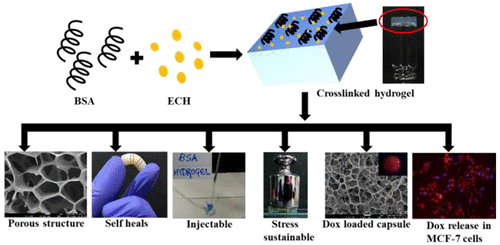当前位置:
X-MOL 学术
›
ACS Sustain. Chem. Eng.
›
论文详情
Our official English website, www.x-mol.net, welcomes your feedback! (Note: you will need to create a separate account there.)
Injectable, Self-Healing, and Stress Sustainable Hydrogel of BSA as a Functional Biocompatible Material for Controlled Drug Delivery in Cancer Cells
ACS Sustainable Chemistry & Engineering ( IF 8.4 ) Pub Date : 2018-01-16 00:00:00 , DOI: 10.1021/acssuschemeng.7b03485 Aekta Upadhyay 1 , Ravinder Kandi 1 , Chebrolu Pulla Rao 1
ACS Sustainable Chemistry & Engineering ( IF 8.4 ) Pub Date : 2018-01-16 00:00:00 , DOI: 10.1021/acssuschemeng.7b03485 Aekta Upadhyay 1 , Ravinder Kandi 1 , Chebrolu Pulla Rao 1
Affiliation

|
Hydrogels have been used in the literature in tissue engineering, in drug delivery, and as enzyme biomimics. Herein, we report the synthesis of a functional biomaterial using BSA as scaffold and epichlorohydrin as cross-linker. The hydrogels reported in this paper were shown to exhibit tunable pore size as a function of BSA concentration by scanning electron microscopy (SEM) and, therefore, are well suited to encapsulate drug molecules for delivery applications. These are injectable, shear thinning, self-healing, and has the ability to withstand a physical weight of ∼300 times of its own. In trypsin medium, the gel is degraded by 50% in 36 h supporting that these are biodegradable. The loading of Dox by the gel was confirmed by the emission of red fluorescence and also by filling the pores by fibrillar structures as demonstrated by SEM. The controlled release of Dox occurs over 5 days to an extent of 37 ± 2%, 26 ± 0.5%, and 21 ± 1.5% in PBS at pH 5.5, 6.8, and 7.4 respectively. Since these hydrogels are made of BSA as matrix, their biocompatibility was proven by MCF-7, HeLa, and MDA-MB-231 cells wherein 95 ± 5% of cells are viable when treated with unloaded hydrogel. However, the Dox loaded hydrogel results in 70–80% of killing in the case of all three cancer cells. Fluorescence microscopy and FACS studies support controlled and time dependent release of Dox in MCF-7 cells for 24 h where the drug goes into cytoplasm initially and then into nucleus. The cell cycle analysis carried out using MCF-7 cells clearly showed that the cell death is due to apoptosis, and this is by arresting the G2/M phase as a function of time. All of the data supports the utility of the synthesized BSA hydrogel as a biomaterial that will find application in controlled drug delivery.
中文翻译:

BSA的可注射,自愈和可承受压力的可持续水凝胶,作为一种功能性生物相容性材料,可控制癌细胞中的药物传递
水凝胶已用于组织工程,药物递送和酶仿生学的文献中。在本文中,我们报道了使用BSA作为支架和环氧氯丙烷作为交联剂的功能性生物材料的合成。本文中报道的水凝胶通过扫描电子显微镜(SEM)显示出可调节的孔径随BSA浓度的变化,因此非常适合封装药物分子以进行递送。它们是可注射的,剪切稀化的,可自我修复的,并具有承受其自身约300倍物理重量的能力。在胰蛋白酶培养基中,凝胶在36小时内降解了50%,这证明它们是可生物降解的。如通过SEM所证实的,通过红色荧光的发射以及通过用纤维状结构填充孔来确认Dox在凝胶上的负载。在pH分别为5.5、6.8和7.4的PBS中,Dox的受控释放在5天之内发生的程度分别为37±2%,26±0.5%和21±1.5%。由于这些水凝胶是以BSA为基质制成的,因此它们的生物相容性已由MCF-7,HeLa和MDA-MB-231细胞证明,其中95±5%的细胞在未加载水凝胶的情况下是可行的。然而,对于所有三种癌细胞,载有Dox的水凝胶可导致70-80%的杀死率。荧光显微镜和FACS研究支持Dof在MCF-7细胞中的受控释放和时间依赖性释放达24小时,其中药物首先进入细胞质,然后进入细胞核。使用MCF-7细胞进行的细胞周期分析清楚地表明,细胞死亡是由于凋亡引起的,这是通过阻止G引起的。分别在pH 5.5、6.8和7.4的PBS中溶解5%。由于这些水凝胶是以BSA为基质制成的,因此它们的生物相容性已由MCF-7,HeLa和MDA-MB-231细胞证明,其中95±5%的细胞在未加载水凝胶的情况下是可行的。然而,对于所有三种癌细胞,载有Dox的水凝胶可导致70-80%的杀死率。荧光显微镜和FACS研究支持Dof在MCF-7细胞中的受控释放和时间依赖性释放达24小时,其中药物首先进入细胞质,然后进入细胞核。使用MCF-7细胞进行的细胞周期分析清楚地表明,细胞死亡是由于凋亡引起的,这是通过阻止G引起的。分别在pH 5.5、6.8和7.4的PBS中溶解5%。由于这些水凝胶是以BSA为基质制成的,因此它们的生物相容性已由MCF-7,HeLa和MDA-MB-231细胞证明,其中95±5%的细胞在未加载水凝胶的情况下是可行的。然而,对于所有三种癌细胞,载有Dox的水凝胶可导致70-80%的杀死率。荧光显微镜和FACS研究支持Dof在MCF-7细胞中的受控释放和时间依赖性释放达24小时,其中药物首先进入细胞质,然后进入细胞核。使用MCF-7细胞进行的细胞周期分析清楚地表明,细胞死亡是由于凋亡引起的,这是通过阻止G引起的。和MDA-MB-231细胞,其中95±5%的细胞在未加载水凝胶的情况下可以存活。然而,对于所有三种癌细胞,载有Dox的水凝胶可导致70-80%的杀死率。荧光显微镜和FACS研究支持Dof在MCF-7细胞中的受控释放和时间依赖性释放达24小时,其中药物首先进入细胞质,然后进入细胞核。使用MCF-7细胞进行的细胞周期分析清楚地表明,细胞死亡是由于凋亡引起的,这是通过阻止G引起的。和MDA-MB-231细胞,其中95±5%的细胞在未加载水凝胶的情况下可以存活。然而,对于所有三种癌细胞,载有Dox的水凝胶可导致70-80%的杀伤力。荧光显微镜和FACS研究支持Dof在MCF-7细胞中的受控释放和时间依赖性释放达24小时,其中药物首先进入细胞质,然后进入细胞核。使用MCF-7细胞进行的细胞周期分析清楚地表明,细胞死亡是由于凋亡引起的,这是通过阻止G引起的。2 / M相位随时间变化。所有数据都支持合成的BSA水凝胶作为一种生物材料的实用性,它将在可控药物递送中得到应用。
更新日期:2018-01-16
中文翻译:

BSA的可注射,自愈和可承受压力的可持续水凝胶,作为一种功能性生物相容性材料,可控制癌细胞中的药物传递
水凝胶已用于组织工程,药物递送和酶仿生学的文献中。在本文中,我们报道了使用BSA作为支架和环氧氯丙烷作为交联剂的功能性生物材料的合成。本文中报道的水凝胶通过扫描电子显微镜(SEM)显示出可调节的孔径随BSA浓度的变化,因此非常适合封装药物分子以进行递送。它们是可注射的,剪切稀化的,可自我修复的,并具有承受其自身约300倍物理重量的能力。在胰蛋白酶培养基中,凝胶在36小时内降解了50%,这证明它们是可生物降解的。如通过SEM所证实的,通过红色荧光的发射以及通过用纤维状结构填充孔来确认Dox在凝胶上的负载。在pH分别为5.5、6.8和7.4的PBS中,Dox的受控释放在5天之内发生的程度分别为37±2%,26±0.5%和21±1.5%。由于这些水凝胶是以BSA为基质制成的,因此它们的生物相容性已由MCF-7,HeLa和MDA-MB-231细胞证明,其中95±5%的细胞在未加载水凝胶的情况下是可行的。然而,对于所有三种癌细胞,载有Dox的水凝胶可导致70-80%的杀死率。荧光显微镜和FACS研究支持Dof在MCF-7细胞中的受控释放和时间依赖性释放达24小时,其中药物首先进入细胞质,然后进入细胞核。使用MCF-7细胞进行的细胞周期分析清楚地表明,细胞死亡是由于凋亡引起的,这是通过阻止G引起的。分别在pH 5.5、6.8和7.4的PBS中溶解5%。由于这些水凝胶是以BSA为基质制成的,因此它们的生物相容性已由MCF-7,HeLa和MDA-MB-231细胞证明,其中95±5%的细胞在未加载水凝胶的情况下是可行的。然而,对于所有三种癌细胞,载有Dox的水凝胶可导致70-80%的杀死率。荧光显微镜和FACS研究支持Dof在MCF-7细胞中的受控释放和时间依赖性释放达24小时,其中药物首先进入细胞质,然后进入细胞核。使用MCF-7细胞进行的细胞周期分析清楚地表明,细胞死亡是由于凋亡引起的,这是通过阻止G引起的。分别在pH 5.5、6.8和7.4的PBS中溶解5%。由于这些水凝胶是以BSA为基质制成的,因此它们的生物相容性已由MCF-7,HeLa和MDA-MB-231细胞证明,其中95±5%的细胞在未加载水凝胶的情况下是可行的。然而,对于所有三种癌细胞,载有Dox的水凝胶可导致70-80%的杀死率。荧光显微镜和FACS研究支持Dof在MCF-7细胞中的受控释放和时间依赖性释放达24小时,其中药物首先进入细胞质,然后进入细胞核。使用MCF-7细胞进行的细胞周期分析清楚地表明,细胞死亡是由于凋亡引起的,这是通过阻止G引起的。和MDA-MB-231细胞,其中95±5%的细胞在未加载水凝胶的情况下可以存活。然而,对于所有三种癌细胞,载有Dox的水凝胶可导致70-80%的杀死率。荧光显微镜和FACS研究支持Dof在MCF-7细胞中的受控释放和时间依赖性释放达24小时,其中药物首先进入细胞质,然后进入细胞核。使用MCF-7细胞进行的细胞周期分析清楚地表明,细胞死亡是由于凋亡引起的,这是通过阻止G引起的。和MDA-MB-231细胞,其中95±5%的细胞在未加载水凝胶的情况下可以存活。然而,对于所有三种癌细胞,载有Dox的水凝胶可导致70-80%的杀伤力。荧光显微镜和FACS研究支持Dof在MCF-7细胞中的受控释放和时间依赖性释放达24小时,其中药物首先进入细胞质,然后进入细胞核。使用MCF-7细胞进行的细胞周期分析清楚地表明,细胞死亡是由于凋亡引起的,这是通过阻止G引起的。2 / M相位随时间变化。所有数据都支持合成的BSA水凝胶作为一种生物材料的实用性,它将在可控药物递送中得到应用。



























 京公网安备 11010802027423号
京公网安备 11010802027423号